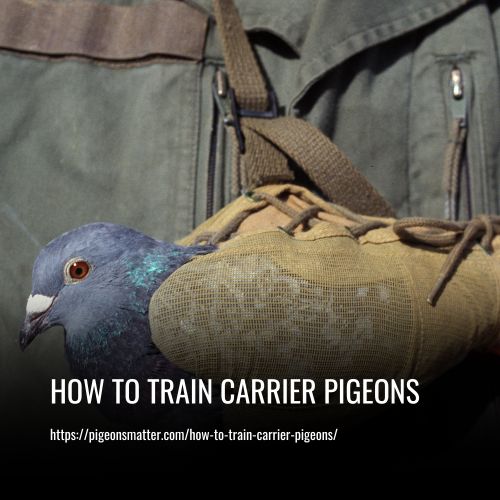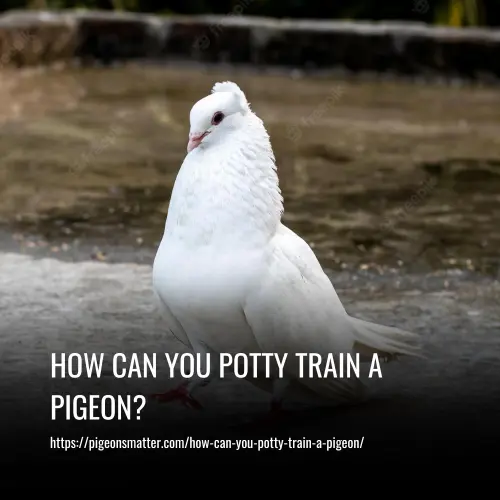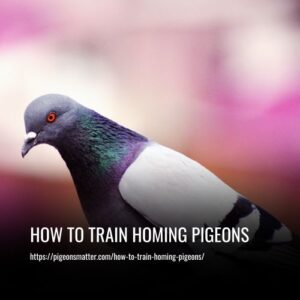Carrier pigeons have been domesticated for around 5,000 years and were once used to transport important messages from one place to another. These birds are trained to carry messages weighing up to 50 grams. Training carrier pigeons may seem daunting, but with the right guidance, anyone can do it.
To Train Carrier Pigeons, Follow These Steps:
- Using The Trapdoor
- Leaving the Loft
- Increasing Distance
- Getting Your Pigeon to Fly Home

How To Train Carrier Pigeons
Training carriers or homing pigeons to return home involves a process that requires patience and consistency. Here are some steps to follow:
1. Using The Trapdoor
Teaching homing pigeons how to use the trapdoor on their loft is a necessary first step before teaching them any other skills. This is how they will enter and exit their home, and it’s crucial that they can do this independently.
Begin the process by giving your pigeon the opportunity to venture outside of its designated living space to become accustomed to the environment. Once your pigeon has mastered this skill, you can move on to teaching them other essential skills.
2. Leaving the Loft
Teaching your pigeon to find its way home is important. Monitoring your pigeon’s progress and helping them learn the necessary skills is crucial. Start by placing your pigeon in a small crate or nest. Move about a mile away from its loft and release the pigeon to fly back home. This will help your pigeon learn without getting lost.
To improve your pigeon’s ability to find its way home, repeat the process several times a week. Gradually increase the distance from the loft as the pigeon becomes more experienced. Always monitor your pigeon’s progress and provide a safe and comfortable environment. With patience and practice, your pigeon will become a skilled navigator and always find its way back home.
3. Increasing Distance
To train your pigeon, start with a one-mile flight from home and gradually increase the distance each week by five miles. Vary the locations and directions of each flight to help the bird become more skilled at finding its way home from different distances and unfamiliar places.
4. Getting Your Pigeon to Fly Home
Getting your pigeon to find its way home can be a worry, but there are ways to make it easier. Pigeons are instinctively homing birds, but you can entice them to return to the loft by providing good quality food and fresh water upon their return. By making coming home more attractive than hunting for its own food and water, your pigeon will be more likely to want to fly back to the loft.
Creating a comfortable and welcoming environment with positive interaction will also encourage your pigeon to return home willingly. With these steps, you can ensure that your pigeon will find its way home without much effort on your part.
The Basics of Training a Carrier Pigeon
To train carrier pigeons, it is important to select the right pigeons based on their physical attributes, genetic disposition, and behavioral tendencies. Look for pigeons with a wingspan of 30 inches or more, a medium-sized body weighing 13-21 ounces, sleek feathers, and sharp vision. Choose pigeons with a strong homing instinct and parents with good performance records.
Additionally, select calm, submissive birds with an inquisitive nature and ensure they are free from health issues or injuries. It can be helpful to consult experienced breeders or trainers for their expertise in pigeon genetics and behavior.
Creating a suitable environment is also crucial for carrier pigeon training. Provide a home loft large enough to accommodate all the pigeons and protect them from predators. Allow the birds time to adjust to their new living space before starting training.
Ensure they have access to clean water and nutritious food, and regularly clean and sanitize the home loft. By setting up a suitable environment that meets their physical and psychological needs, you can enhance the success of training sessions and have reliable messenger pigeons.
Training Methods for Carrier Pigeons
Training carrier pigeons requires a combination of food and water incentives, as well as practice and endurance building.
1. Food and Water Incentives
Feeding carrier pigeons a proper diet is crucial for improving their performance. Using treats as rewards during training sessions can also encourage desired behaviors. Establishing a feeding schedule that aligns with training sessions helps the pigeons associate food with their training. Water can be used as a reward for completing tasks. Patience and consistency in messaging are key, and varying the types of treats used can help keep the pigeons engaged.
2. Practice and Endurance Building
Training carrier pigeons takes time and perseverance. Repetitive exercises and physical conditioning are necessary for successful message deliveries. Providing regular exercise opportunities, both indoors and outdoors, allows the pigeons to strengthen their flight muscles. Gradually increasing the distances covered during training flights helps them build up stamina. Scheduled training sessions help establish a routine and develop specific flight patterns and navigational skills.
It’s also important to vary flight routes, introduce obstacles, and monitor the pigeons’ health. These measures contribute to improving practice and building endurance, ultimately increasing the success rate of message deliveries and maintaining a strong bond between trainers and their feathered companions.
When to Start Training Your Carrier Pigeon
Getting the timing right is crucial when training homing pigeons. Starting too early or too late can affect the success of your training. Experts recommend starting at around six weeks, as this is when pigeons begin to develop the skills necessary to be successful homing pigeons.
At this stage, they are also able to remember the location of their coop or nest, which is an important aspect of homing pigeon training. Starting at the right time can set your pigeons up for success and increase their chances of becoming reliable homing pigeons.
What You Will Need
Training carrier pigeons require specific materials and a different approach than keeping pigeons as pets. To train carrier pigeons, you’ll need a loft or dovecote with a trap door for releasing the pigeons. The loft should provide 10 cubic feet of space for each pair of homing pigeons and be located in a safe area away from predators and obstacles. If breeding pigeons, a separate area for nesting and incubating eggs is necessary.
In addition to the loft, you’ll need to provide food for your pigeons, including a mix of seeds, grains, protein, fruits, and vegetables. Water and grit may also be necessary for digestion. It’s recommended to offer food at set times instead of leaving it available all day and night.
Overall, it’s important to have the proper materials and environment to train carrier pigeons successfully. Start with a small space and expand as necessary to meet the needs of your pigeons.
Considerations to Keep in Mind
When training your homing pigeon, it’s important to remember that the distance you take it will affect the time it takes to fly back home. As you increase the distance, it may take more than a day for your pigeon to return to the loft. It’s important to be patient and avoid waiting around for your pigeon to come back.
Trust in the training you’ve given your pigeon and give it the time it needs to find its way home. While it may be difficult to let go, allowing your pigeon to complete the journey on its own is an important part of the training process.
How Do Pigeons Know Where To Deliver Messages?
Pigeons are often used to deliver messages, but how do they know where to go? The answer is simple: they are trained to fly back to their home. When a note is attached to a pigeon, it will fly back to its home once released. This means that you cannot send a pigeon to multiple addresses, as it will only return to its trained home.
Training pigeons to deliver messages is a fascinating process that has been used for centuries. It requires patience and dedication, but the rewards can be great. Pigeons have been used in times of war and for important communication, making them an important part of human history.
Tips and Tricks for Successful Pigeon Training
1. Training Schedule for Pigeons
Setting up a daily schedule is essential for successful pigeon training. This allows you to dedicate the time and effort needed to train your pigeons effectively. By creating a consistent timeline for training sessions, you can ensure that your pigeons have the opportunity to get the exercise they need to return home.
2. The Importance of Banding
Banding your pigeons is crucial for their identification and can greatly increase the chances of recovering a lost bird. Pigeon clubs provide resources for reporting lost pigeons and reuniting them with their owners. Failing to band your pigeons could result in losing them if they get lost, so it is a critical responsibility for every pigeon trainer.
3. Patience and Perseverance
Trainers must have patience and perseverance when training carrier pigeons. It takes time for the birds to learn and respond, so perseverance through challenges is necessary. Gradual acclimation, creating a suitable environment, and using proper training methods are key. Positive reinforcement, like food and water incentives, helps build resilience and physical stamina.
4. The Significance of Clear Messages
Clear messages are critical for training carrier pigeons. Using simple, concise language helps the pigeons deliver the payload accurately. Creating a suitable environment is also essential for training carrier pigeons. A secure and comfortable home loft helps the pigeons feel safe and at ease when getting instructions and preparing for their journeys.
5. Enjoy the Process
Training homing pigeons can be a unique and enjoyable hobby, especially for bird enthusiasts. Pigeons make great pets and can form strong bonds with their trainers, making them eager to perform well.
FAQs
Training a carrier pigeon typically takes several weeks. During this time, you will gradually release the young pigeon from different locations and increasingly farther away from the loft entrance. This helps them develop their homing instinct and learn to fly back to the loft from any release point. The homing instinct is usually established at around 8 weeks of age.
Pigeons are easy to learn and quickly adapt to household routines. They can live peacefully with other pets like dogs and cats, as long as they are kept safe. Pigeons are emotional creatures and require a companion, whether it’s another bird or a human, to spend their day with.
You should start training homing pigeons when they are at least 6 weeks old. It’s important to help them understand how to use the trapdoor in the loft at this age. The trapdoor allows the pigeons to enter the loft freely but can be set to only let them out when desired. It’s also recommended to create a training schedule to follow daily for consistency and to ensure you’re prepared for each session. This schedule should include training the pigeons at least once a day.
No, training a pigeon is not difficult. It just requires time, dedication, and proper care. Training homing pigeons can be easy and simple with the right approach.
The main difference between a carrier pigeon and a homing pigeon is the purpose for which they were bred. Carrier pigeons were bred for their beauty, while homing pigeons were bred for their speed and ability to return home. Both are the result of selective breeding from the rock pigeon, a wild pigeon known for its homing instincts.
Conclusion
Training carrier pigeons can be a fun and rewarding experience. Whether you’re using them for a hobby or business, these birds are incredibly intelligent and capable of learning a wide range of skills.
So, if you’re ready to take on the challenge, grab some treats and get to work. With patience, consistency, and lots of positive reinforcement, you’ll have a team of skilled pigeons in no time!

